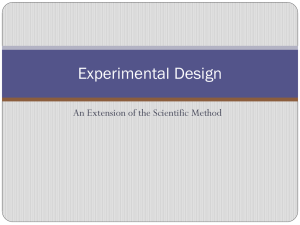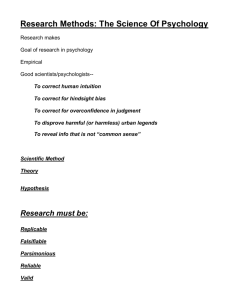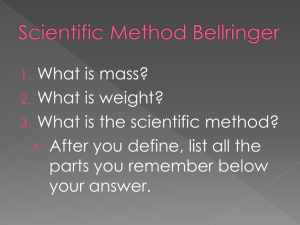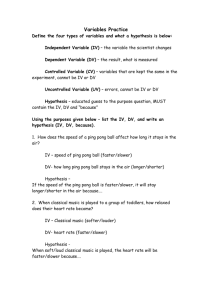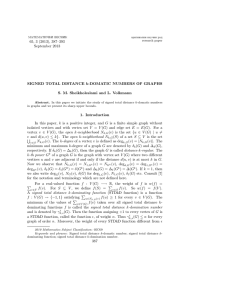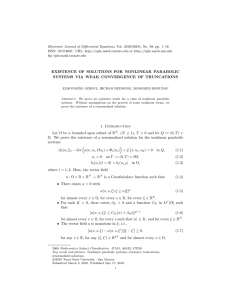Scientific Method PPT
advertisement
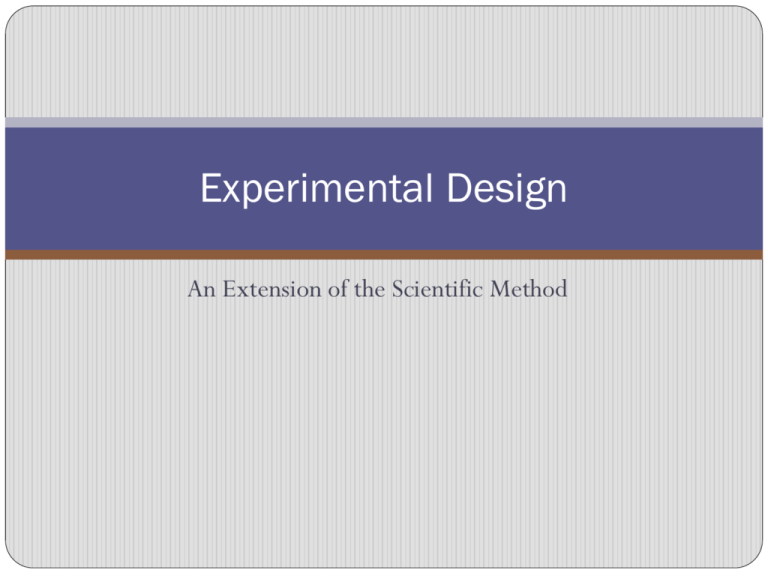
Experimental Design An Extension of the Scientific Method Objectives Distinguish between independent and dependent variables. Formulate a tentative, testable hypothesis complete with independent and dependent variables. The Scientific Method Process used to study, investigate, and provide explanations for observed phenomenon in the natural world It is empirical Meaning that it’s based on experience and observations that are rational, testable, and repeatable Steps of the Scientific Method 1. Make observations 2. Formulate a hypothesis 3. Devise a testable prediction 4. Conduct a critical experiment 5. Draw conclusions and make revisions Research Question What are your interests? Choose a topic Importance of preliminary research – research before you experiment Measurements Safety precautions Clear and focused Bad Research Question Example What is the effect of global warming on animals? Good Research Question Example How is glacier melting affecting penguins of Antarctica? Clear Specific Focused Hypothesis A tentative (changeable) and testable proposed explanation for an observable phenomenon Example: I think the termite will like the yellow highlighter. With a good hypothesis, a prediction can be created in an “if- then” statement Example: If the termite walks toward the yellow highlighter, then it must like it. Purpose of the hypothesis Tentative and testable State the research question Identify the variables Do oranges sink or float? Independent Variable The manipulated variable Quantity or quality is changed throughout the experiment Dependent Variable The responding variable “depends on the independent variable” Is measured (this is the data you record for your experiment) Matching Activity The increase in sunlight exposure of a tomato plant will increase the plant’s growth. Increasing intake of sugary beverages, like soda and juice, will increase the amount of body fat in humans. IV- sunlight exposure DV- plant growth IV- amount of sugary beverages ingested DV- amount of body fat Matching Activity The increase in sunlight exposure of a tomato plant will increase the plant’s growth. Increasing intake of sugary beverages, like soda and juice, will increase the amount of body fat in humans. IV- sunlight exposure DV- plant growth IV- amount of sugary beverages ingested DV- amount of body fat Matching Activity The increase in sunlight exposure of a tomato plant will increase the plant’s growth. Increasing intake of sugary beverages, like soda and juice, will increase the amount of body fat in humans. IV- sunlight exposure DV- plant growth IV- amount of sugary beverages ingested DV- amount of body fat More Matching If a prisoner learns a work skill while in jail, then he is less likely to commit a crime when he is released. If the ambient temperature increases, then an animal’s rate of metabolism will increase. IV- learning of a work skill DV- likelihood of committing a crime IV- ambient temperature DV- rate of metabolism More Matching If a prisoner learns a work skill while in jail, then he is less likely to commit a crime when he is released. If the ambient temperature increases, then an animal’s rate of metabolism will increase. IV- learning of a work skill DV- likelihood of committing a crime IV- ambient temperature DV- rate of metabolism More Matching If a prisoner learns a work skill while in jail, then he is less likely to commit a crime when he is released. If the ambient temperature increases, then an animal’s rate of metabolism will increase. IV- learning of a work skill DV- likelihood of committing a crime IV- ambient temperature DV- rate of metabolism Example Hypotheses If the amount of sediment in a river increases, then the water velocity will decrease. If the amount of salt in the soil increases, then the plant rate of growth will decrease. If fenders are placed on a bicycle, then the user will stay dry when going through puddles. Let’s talk about the oranges… Floating vs. sinking With the peel vs. without the peel Orange Hypothesis What was your original hypothesis regarding the oranges? Was your hypothesis supported or proved false? When choosing variables… consider time, monetary, and safety constraints Hypothesis Experimental Group The groups or trials that receive all the same conditions except varying amounts or qualities of the independent variable (IV) Example: presence of red pen Trial- replication of the experimental and control group Control Group Group in the experiment that receives the exact same conditions as the experimental groups except that the independent variable is not changed Used as a comparison group Example: plain white paper
